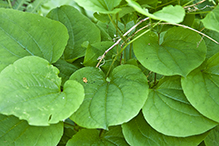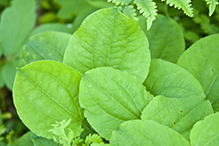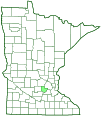roundleaf greenbrier
(Smilax rotundifolia)
Conservation • Wetland • Description • Habitat • Ecology • Use • Distribution • Taxonomy
Description |
||
Roundleaf greenbrier is a climbing, perennial, woody vine that rises on a single or multiple stems from a linear rhizome. The stems are slender, green, woody, hairless, branching, and up to 20′ long. They are usually 4-angled, sometimes round. They are armed with stout, flattened, up to ½″ long prickles. The prickles are green with a black tip. The leaves are alternate and deciduous. They are evenly distributed along the vine. They are on 3 ⁄16″ to ⅝″ long leaf stalks. The leaf stalks are shorter than the leaf blades. There is a pair of up tendrils at the base of many of the leaf stalks. The leaf blades are broadly egg-shaped to nearly circular, 1½″ to 6¾″ long, and 1½″ to 6¼″ wide. They are heart-shaped to rounded at the base and rounded at the tip with a short, sharp, abrupt point at the tip. The upper surface is bright green, shiny, and hairless. The lower surface is the same color as the upper surface, hairless, and sometimes shiny. The lower surface is not covered with a whitish, waxy bloom (glaucous). There are 3, 5, or 7 conspicuous main veins that arch from the base of the leaf blade and converge toward the tip. The main veins are impressed on the upper surface, raised on the lower surface. The margin is not thickened, lobed, or toothed, but may have a few scattered, minute, tooth-like projections. The inflorescence is an globe-shaped, 1½″ in diameter, umbrella-like cluster (umbel) of 5 to 12, sometimes more, flowers rising from the leaf axils. The umbel is on a stalk that is up to ⅝″ long, shorter to slightly longer than the subtending leaf stalk. Male and female flowers are borne on separate plants. There are 3 greenish-yellow, strap-shaped petals and 3 similar sepals (6 tepals). The male flowers have 6 stamens with yellow anthers. They appear in late May to late June. The fruit is a glaucous, bluish-black to black, globular berry, ¼″ to ⅜″ in diameter. |
||
Height |
||
Up to 20′ |
||
Flower Color |
||
Greenish-yellow |
||
Similar Species |
||
Bristly greenbrier (Smilax tamnoides) has flexible, needle-like prickles. The fruit is not glaucous. |
||
Habitat |
||
Woodland openings, thickets, roadsides. |
||
Ecology |
||
Flowering |
||
May to June |
||
Pests and Diseases |
||
|
||
Use |
||
|
||
Distribution |
||||
|
Sources Roundleaf greenbrier does not occur in Minnesota outside of cultivation. USDA PLANTS and GRIN show the species as native to Minnesota but with no county records. The Darlene and William Radichel Herbarium, Minnesota State University Mankato, has a single specimen. However, no date or location for the specimen is given, and no other records can be found. The map at left shows its presence in Carver County at the Minnesota Landscape Arboretum, where the photographs on this page were taken. |
|||
| 4/26/2021 | ||||
Nativity |
||||
Naitve to northeastern, southeastern, north-central, and south-central United States, and to eastern Canada. |
||||
Occurrence |
||||
Not present in Minnesota |
||||
Taxonomy |
|||
| Kingdom | Plantae (Plants) | ||
| Division | Tracheophyta (Vascular Plants) | ||
| Subdivision | Spermatophytina (Seed Plants) | ||
| Class | Liliopsida (Monocots) | ||
Order |
Liliales (lilies, supplejacks, and allies) | ||
Family |
Smilacaceae (greenbrier) | ||
Genus |
Smilax (greenbriars) | ||
Synonyms |
|||
Smilax rotundifolia var. crenulata Smilax rotundifolia var. quadrangularis |
|||
Common Names |
|||
bullbrier common catbriar common greenbrier greenbrier horsebriar roundleaf greenbriar roundleaf greenbrier |
|||
Glossary
Axil
The upper angle where a branch, stem, leaf stalk, or vein diverges.
Glaucous
Pale green or bluish gray due to a whitish, powdery or waxy film, as on a plum or a grape.
Linear
Long, straight, and narrow, with more or less parallel sides, like a blade of grass.
Rhizome
A horizontal, usually underground stem. It serves as a reproductive structure, producing roots below and shoots above at the nodes.
Sepal
An outer floral leaf, usually green but sometimes colored, at the base of a flower.
Tepal
Refers to both the petals and the sepals of a flower when they are similar in appearance and difficult to tell apart. Tepals are common in lilies and tulips.
Umbel
A flat-topped or convex, umbrella-shaped cluster of flowers or buds arising from more or less a single point.
Visitor Photos |
|||||
Share your photo of this plant. |
|||||
| This button not working for you? Simply email us at info@MinnesotaSeasons.com. Attach one or more photos and, if you like, a caption. |
|||||
|
|||||
MinnesotaSeasons.com Photos |
|||||
 |
 |
||||

Slideshows |
||

Visitor Videos |
|||
Share your video of this plant. |
|||
| This button not working for you? Simply email us at info@MinnesotaSeasons.com. Attach a video, a YouTube link, or a cloud storage link. |
|||
Other Videos |
|||
| Wild Edibles - The Common Greenbrier The Backwoodsman's Institute |
|||
About
Uploaded on Apr 21, 2010 The Backwoodsman's Institute presents: Wild Edibles - The Common Greenbrier. In this video, Scott shares with you yet another wild edible, the common greenbrier. This edible you can eat raw right off the stem. |
|||

Visitor Sightings |
|||||
Report a sighting of this plant. |
|||||
| This button not working for you? Simply email us at info@MinnesotaSeasons.com. Be sure to include a location. |
|||||
|
|||||
MinnesotaSeasons.com Sightings |
|||||
|
|||||

|
Created: Last Updated: © MinnesotaSeasons.com. All rights reserved. |
